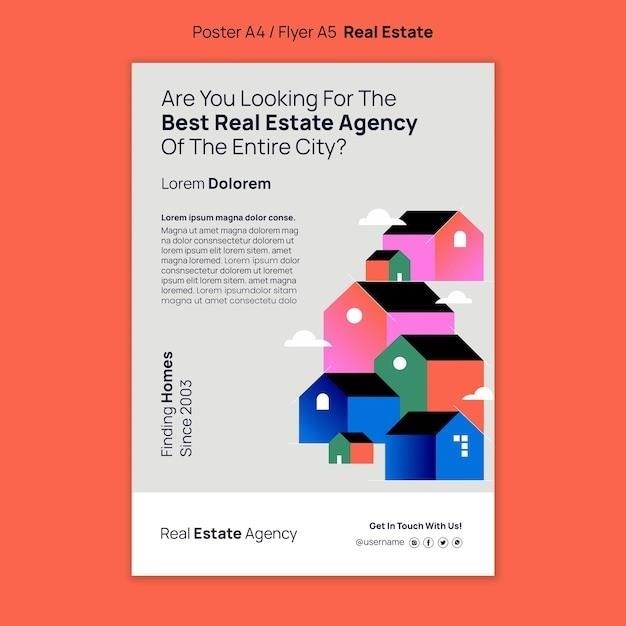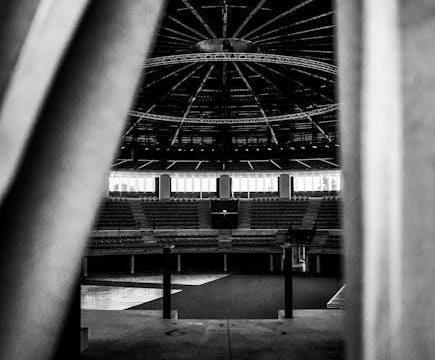Low Rise Housing Diversity Design Guide⁚ A Comprehensive Overview
This guide is a valuable resource for developers, designers, and councils, providing clear direction on achieving consistent design standards across various low-rise housing types. The guide offers a comprehensive framework for dual occupancies, manor houses, and terraces, ensuring quality design outcomes that enhance housing choice and affordability.
Introduction
The Low Rise Housing Diversity Design Guide for Complying Development is a crucial tool for ensuring high-quality design standards across various low-rise housing types in NSW. It is a direct result of the Low Rise Housing Diversity Code, formerly known as the Low Rise Medium Density Housing Code, which aims to streamline development approval processes and encourage a greater diversity of housing options. The guide provides clear and concise design criteria for dual occupancies, manor houses, and terraces, ensuring consistent planning and design standards across the state. This comprehensive guide is a vital resource for developers, designers, and councils seeking to promote sustainable and aesthetically pleasing low-rise housing developments.
The guide emphasizes the importance of factors like layout, landscaping, private open space, light, natural ventilation, and privacy, ensuring a holistic approach to design that enhances the livability and functionality of these housing types. By providing a clear framework and design standards, the guide promotes consistency and quality across diverse housing projects, contributing to a more vibrant and diverse housing landscape in NSW.
Benefits of the Low Rise Housing Diversity Code
The Low Rise Housing Diversity Code (formerly known as the Low Rise Medium Density Housing Code) offers a range of benefits for developers, residents, and NSW itself. From a developer’s perspective, the Code significantly reduces the time required to obtain development approval for this housing type. This translates to less costly design revisions and a more efficient development process.
For residents, the Code promotes greater housing choice and affordability. The increased variety of housing options caters to diverse needs and budgets, offering alternatives to traditional apartments and freestanding homes. By encouraging denser development within existing neighbourhoods, the Code contributes to more vibrant and walkable communities.
Finally, for NSW, the Code helps address the growing demand for housing while promoting sustainable development practices. The design guide emphasizes factors like landscaping, natural ventilation, and privacy, ensuring that new developments are both attractive and environmentally conscious. The Code’s focus on quality design and consistent standards contributes to the overall quality of life and livability of NSW communities.

Design Guide for Complying Development
The Low Rise Housing Diversity Design Guide for Complying Development acts as a comprehensive resource for councils when assessing development applications for dual occupancies, manor houses, and terraces. It provides clear and consistent planning and design standards, ensuring that these housing types are integrated seamlessly into existing streetscapes and neighbourhoods.
The guide emphasizes the importance of good design outcomes, focusing on factors like layout, landscaping, private open space, light, natural ventilation, and privacy. This comprehensive approach ensures that developments are not only functional but also aesthetically pleasing and contribute positively to the surrounding environment.
By providing a clear framework for complying development, the guide streamlines the approval process, making it easier for developers to obtain permits and bring their projects to fruition. This, in turn, helps stimulate the supply of diverse housing options, contributing to greater choice and affordability for residents.
Key Features of the Design Guide
The Low Rise Housing Diversity Design Guide is designed to facilitate the creation of diverse and high-quality low-rise housing options. It incorporates a range of key features that aim to enhance design outcomes and ensure consistency across various projects.
One of the central features is the emphasis on providing adequate private open space. This includes balconies, courtyards, and gardens, which contribute to the livability and enjoyment of the dwellings. The guide also promotes the use of sustainable design principles, encouraging the integration of natural light, ventilation, and energy-efficient features.
Furthermore, the guide addresses the importance of creating a sense of place and community. It encourages the use of landscaping, street trees, and pedestrian-friendly pathways to foster a welcoming and connected neighbourhood environment. By incorporating these key features, the guide aims to create a more diverse and vibrant housing landscape in NSW.
Dual Occupancies⁚ Design Criteria
The Low Rise Housing Diversity Design Guide provides specific design criteria for dual occupancies, ensuring that these developments meet quality standards and integrate seamlessly into the surrounding environment. The guide addresses key aspects of design, including⁚
- Site Coverage and Building Height⁚ The guide sets limits on the maximum site coverage and building height for dual occupancies, ensuring that they do not dominate the site or overshadow neighbouring properties.
- Setbacks and Landscaping⁚ The guide outlines specific setback requirements from boundaries and encourages landscaping to enhance the visual appeal and create a sense of privacy.
- Private Open Space⁚ Each dwelling in a dual occupancy must have a designated private open space, such as a courtyard or balcony, providing residents with a dedicated outdoor area.
- Access and Parking⁚ The guide specifies requirements for access and parking, ensuring that dual occupancies are easily accessible and have adequate parking provisions.
- Building Materials and Design⁚ The guide encourages the use of materials and design elements that complement the existing character of the neighbourhood, promoting a sense of harmony and integration.
These design criteria aim to create dual occupancies that are both functional and aesthetically pleasing, contributing to a diverse and thriving housing landscape.
Manor Houses⁚ Design Criteria
The Low Rise Housing Diversity Design Guide provides specific design criteria for manor houses, ensuring that these developments are both visually appealing and functional, while respecting the character of the surrounding neighborhood. These criteria address key aspects of design, including⁚
- Site Coverage and Building Height⁚ The guide establishes limitations on the maximum site coverage and building height for manor houses, ensuring that they do not dominate the site or overshadow neighboring properties. This promotes a balanced and harmonious streetscape.
- Setbacks and Landscaping⁚ The guide specifies setback requirements from boundaries and encourages thoughtful landscaping to enhance the visual appeal of manor houses and create a sense of privacy for residents. This promotes a welcoming and integrated appearance.
- Private Open Space⁚ Manor houses must have designated private open spaces, such as courtyards or balconies, providing residents with a dedicated outdoor area. These areas contribute to the overall livability and quality of life.
- Building Materials and Design⁚ The guide encourages the use of materials and design elements that complement the existing character of the neighborhood, promoting a sense of harmony and integration. This ensures that manor houses fit seamlessly into the existing streetscape.
- Access and Parking⁚ The guide specifies requirements for access and parking, ensuring that manor houses are easily accessible and have adequate parking provisions. This promotes convenience and safety for residents and visitors.
These design criteria aim to ensure that manor houses are well-integrated, aesthetically pleasing, and contribute to a diverse and thriving housing landscape.
Terraces⁚ Design Criteria
The Low Rise Housing Diversity Design Guide sets forth specific design criteria for terraces, ensuring that these developments contribute to a diverse and aesthetically pleasing urban environment. These criteria address key aspects of design, including⁚
- Building Height and Setbacks⁚ The guide establishes limitations on the maximum building height and setbacks for terraces, ensuring that they do not dominate the streetscape or overshadow neighboring properties. This promotes a harmonious and balanced streetscape.
- Street Frontage Design⁚ The guide encourages engaging street frontage design, incorporating elements like balconies, verandahs, or awnings, to create a welcoming and active street presence. This promotes a vibrant and pedestrian-friendly environment.
- Private Open Space⁚ The guide specifies requirements for private open space, such as courtyards or balconies, ensuring that terrace residents have access to dedicated outdoor areas. This contributes to the overall livability and quality of life.
- Building Materials and Design⁚ The guide encourages the use of materials and design elements that complement the existing character of the neighborhood, promoting a sense of harmony and integration. This ensures that terraces fit seamlessly into the existing streetscape.
- Access and Parking⁚ The guide specifies requirements for access and parking, ensuring that terraces are easily accessible and have adequate parking provisions. This promotes convenience and safety for residents and visitors.
These design criteria aim to ensure that terraces are well-integrated, aesthetically pleasing, and contribute to a diverse and thriving housing landscape.
Design Standards and Consistency
The Low Rise Housing Diversity Design Guide emphasizes consistency in design standards across diverse housing projects. This ensures that developments complement each other, contributing to a cohesive and harmonious urban environment; The guide outlines key design principles to achieve this consistency⁚
- Building Envelope⁚ The guide establishes clear guidelines for building envelopes, including height, setbacks, and site coverage, ensuring that developments maintain a consistent scale and footprint within the neighborhood.
- Architectural Style and Materials⁚ The guide promotes the use of architectural styles and materials that complement the existing character of the neighborhood, fostering a sense of continuity and visual harmony.
- Landscape Design⁚ The guide encourages consistent landscape design principles, including the use of native vegetation, permeable paving, and rainwater harvesting, creating a unified and sustainable streetscape.
- Access and Circulation⁚ The guide emphasizes clear and consistent access and circulation patterns, ensuring that pedestrian and vehicular movement flows seamlessly within the development and the surrounding neighborhood.
- Public Realm⁚ The guide promotes the creation of high-quality public spaces, such as shared courtyards, pocket parks, and communal gardens, enhancing the overall livability and amenity of the development.
These design standards promote a cohesive and visually appealing urban environment, ensuring that diverse housing projects contribute to a well-integrated and thriving neighborhood.
Impact on Housing Choice and Affordability
The Low Rise Housing Diversity Design Guide aims to address the increasing need for diverse and affordable housing options in NSW. By promoting the development of dual occupancies, manor houses, and terraces, the guide expands the housing market, offering a wider range of choices for residents. These housing types are often more affordable than traditional detached houses, making homeownership more accessible to a broader segment of the population.
The guide’s focus on quality design and sustainable features further enhances affordability. By encouraging efficient use of space, natural ventilation, and energy-saving materials, the guide helps minimize construction costs, making these housing types more attractive to developers and, ultimately, more affordable for buyers. The guide also encourages the inclusion of shared amenities, such as courtyards and community gardens, further enhancing the affordability and livability of these developments.
By promoting a diverse range of housing options, the Low Rise Housing Diversity Design Guide contributes to a more inclusive and equitable housing market, providing greater choice and affordability for residents of NSW.
The Low Rise Housing Diversity Design Guide represents a significant step towards addressing the growing demand for diverse and affordable housing in NSW. By providing a comprehensive framework for designing dual occupancies, manor houses, and terraces, the guide ensures consistent design standards that enhance the quality and livability of these housing types. This approach not only promotes a wider range of housing choices but also contributes to affordability, making homeownership more accessible to a broader segment of the population.
The guide’s emphasis on quality design, sustainability, and community integration fosters a more inclusive and equitable housing market. It encourages developers to create innovative and attractive housing options that are responsive to the needs and preferences of diverse communities. The guide serves as a valuable resource for developers, designers, and councils, ensuring that the development of low-rise housing in NSW meets the highest standards of design and sustainability.
Ultimately, the Low Rise Housing Diversity Design Guide is a crucial tool for creating vibrant and sustainable communities in NSW. It fosters a more diverse and affordable housing market, enhancing the quality of life for residents and contributing to the overall well-being of the state.






